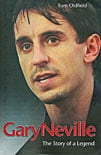 The Story Of A Legend
The Story Of A Legend
by Tom Oldfield
John Blake, £17.99
Reviewed by Jonathan O’Brien
From WSC 246 August 2007
Gary Neville is sometimes described as a throwback to a simpler, financially poorer, more sepia-toned generation of footballers, what with all the “union man” stuff, the 15-year stay at one club and the general tidy efficiency of his play. What gets mentioned less frequently, though, is that thing on his top lip, a slimline version of the kind of soup-strainer you used to see adorning the faces of Liverpool players 30 years ago. Visually, if nothing else, he belongs to a bygone age.
The gobby assertiveness of Neville’s persona has, over the years, ended up slightly obscuring his formidable abilities as a defender. It’s difficult to recall the last left-sided attacker who gave him a genuinely hard time. More telling, perhaps, is the fact that his position is the one area of the Manchester United team that Ferguson hasn’t tinkered with in the last decade and a half.
Mildly opinionated multi-millionaire, dressing-room mouthpiece, fine defender: Neville is all these things and a couple more. What he isn’t is a juicy subject for an author. Many reviews of biographies end with the assertion that “there’s a great book to be written about X, but this isn’t it”. Where Neville is concerned, there’s no great book waiting to be written. He’s a normal man with a bit of a mouth on him and, the wanton goading of Liverpool fans aside, has kept his nose clean at every turn of his career. But that’s still no excuse for the cliche-sodden, woefully syntaxed, barefacedly bad hackery that litters these pages. Neville didn’t co-operate with it, which is probably a blessing in some regards, but calling it a cut-and-paste job would endow it with a gravitas it doesn’t deserve.
Almost the entire book is an endless laundry list of United’s results year after year, with most games being described by their scorelines and little else. The 4-1 defeat of Newcastle in the FA Cup semi-final in 2005 is noted with the following: “Neville thoroughly enjoyed the win and it kept United on course for silverware.” Of a 5-2 rout of Wimbledon in late 1997, Oldfield writes: “It was not, though, one of Gary’s better games, as he openly admits, but he sets such high standards for himself that any misplaced passes or bad decision-making really frustrates him. He even had a shot from distance that flew well wide – something Alex Ferguson commented on at half-time!”
Reading passages like this, you wonder whether Oldfield is pitching the book at bright five-year-olds. He takes two pages to skate over the Rio Ferdinand affair of late 2003, one of the few vaguely interesting episodes in Neville’s career, and even when he gets to the 1999 Treble he isn’t sufficiently clued up about his subject to mention that Neville played a role in Teddy Sheringham’s equaliser in the Champions League final, winning the initial corner.
Even if this book were any good, it would be hard to imagine its presumed target market. Neville simply isn’t an intrinsically interesting character, no matter how many times he shoots his mouth off or how much Liverpool fans despise him, and not many hacks could shape the drab details of such a colourless (though remorselessly proficient) career into something worth reading. Perhaps that’s why the author hasn’t bothered trying.